1 Focus on quality as opposed to breed: the ICBF active bull list for AI beef sires clearly shows that the variation in the terminal and replacement index within breeds is much greater than the variation across breeds. The message is clear – the quality of the bull is more important than the breed.
Know your system and what you want the cattle to do within your system. If it’s the weanling market, a continental animal will be your choice, while if you are trying to finish cattle off grass at the end of the second grazing season, you need a traditional breed like Hereford, Shorthorn or Aberdeen Angus.
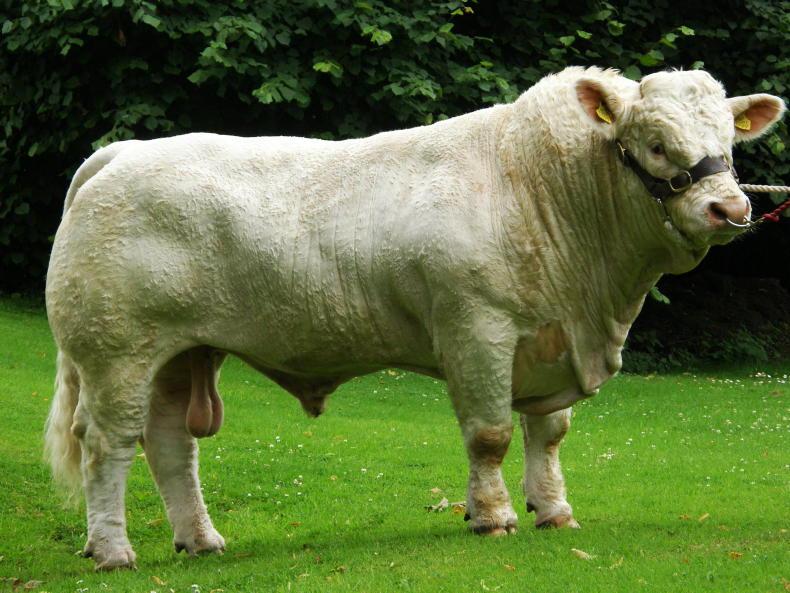
The herd stock bull Clonoulty Andraemon.
2 Buy the bull early: a lot of farmers make the mistake of purchasing the bull the day they want to put them to work. Take time to plan, keeping in mind the desired conception and calving dates for your herd, and just as importantly the production targets you want to obtain.
The bull should be purchased at least one month before his intended use, giving him time to adjust and settle in a new environment.
Make sure the bull has a ring and also make sure that he has a valid fertility test to avoid any fertility issues.
3 Don’t buy a bull on visual assessment alone: while visual assessment is still important, it should not be used as the only means of assessing the quality of the bull. You should also use the ICBF indexes when identifying which bull is best suited to your production system.
For example, if you are finishing all your animals then the terminal index is the most important index to concentrate on.
If you are a part-time farmer, then obviously you should also focus on a low calving difficulty percentage. If you are breeding replacements you need to focus on the replacement index more than the terminal index. Equally, don’t go on figures alone.
Over the last few years, I have seen more and more young people, in particular, landing to a bull sale with a list of bulls picked out of the catalogue and this is all they will look at in the sale.
Bulls could have three legs or two legs but they will still pick that bull because he is right on paper. This is not a good strategy to breed the cattle you want.
The best thing to do is look at the bull first and make sure you are happy with him, then look at his bloodlines to see if you like them and then make sure he has the figures to match before you select him as a potential purchase.
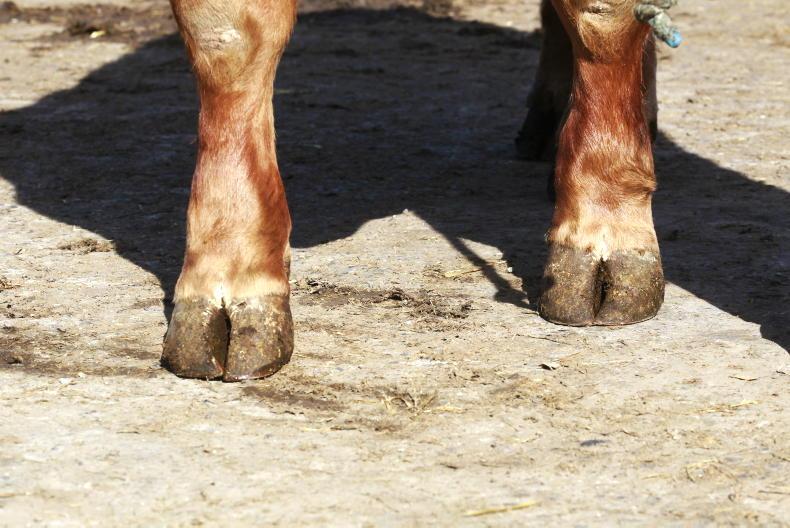
Look for any signs of paring on the feet which can be a sign of overfeeding.
4 Get the sale catalogue in time: a catalogue will usually be available seven to 10 days before the sale, and will provide essential information that you can use to make an informed decision and purchase exactly what you are looking for in your breeding programme.
Before opening the catalogue, rank the traits that are important to you. For example, is calving ease more important than milk or is daughter calving interval more important than beef carcase?
When you have the traits ranked, go to your catalogue and based on the figures/star ratings, identify a selection of bulls that are best suited to deliver what you require.
Remember, the recent changes in relation to the Suckler Carbon Efficiency Programme (SCEP) means that once a bull was genotyped four- or five-star on the September evaluation that means they are OK for siring eligible calves in SCEP.
The most recent evaluation will be printed in the catalogue but you also need to know the September 2023 figures if the bull has dropped since that. This will more than likely be highlighted.
5 Get to the sale early: the show will usually start between one and two hours before the start of sale. It is essential that you put this time to good use.
Get around and look at the bulls on your shortlist. If they are haltered, ask for them to be brought out on to a clean concrete area where you can get a close look at their feet.
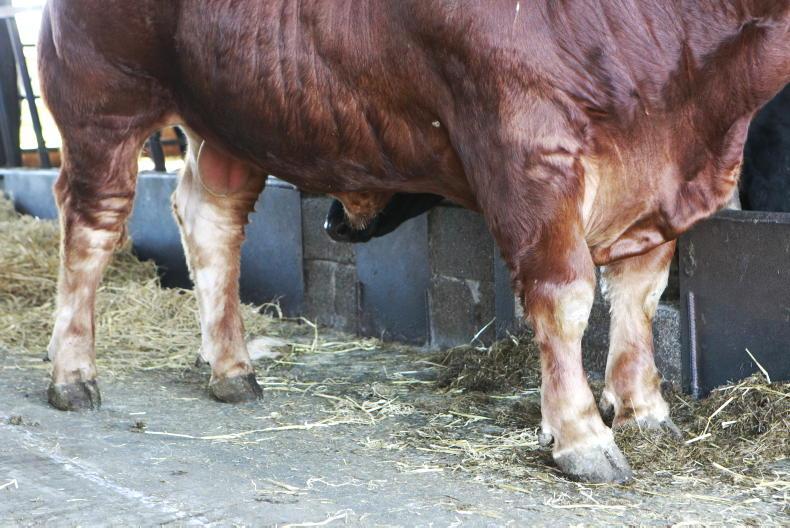
Look for any signs of their feet having been pared. In the case of a young bull, if there is evidence of paring having already been carried out, stay well clear.
Pay close attention to how the bull walks. He should be moving freely and show no signs of stiffness or lameness.
By the time the sale is about to begin, you should have your shortlist reduced to two or three bulls. Never impulse-buy a bull that is not on your list just because you think he is cheap.
6 Talk to the breeder of the bull after the sale: if you have been successful in buying a bull, make sure to talk to the breeder after the sale. The key information you require is the feeding regime for the bull, eg what type of ration he was being fed, and the health status of the bull. Also, find out what vaccinations he received. For example, has he been vaccinated for blackleg, BVD, etc? Don’t forget to get a good luck penny!
7 Get the bull home and settled: get your new bull home and settled as soon as possible. Try to put him into a well-bedded pen where he can see other cattle and, where possible, try to get a few bags of the same ration that he was being fed before you purchased him. This will help reduce stress levels.
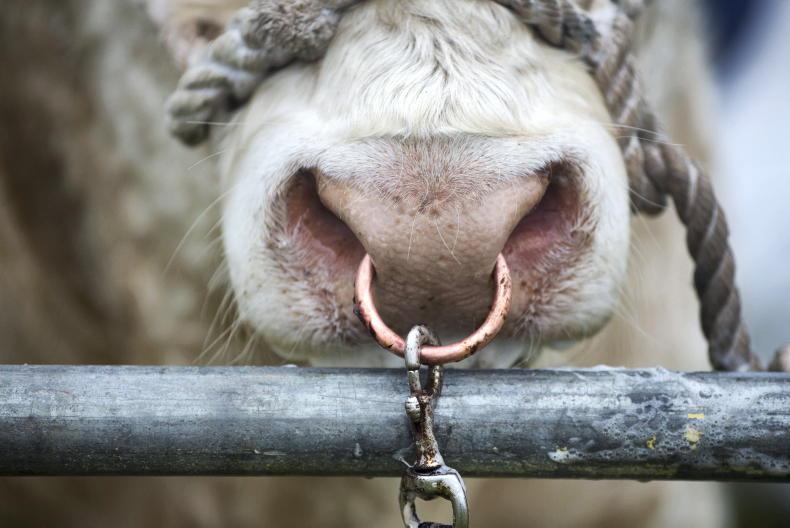
Remember, young bulls have had no breeding experience and therefore should not be treated in the same way as a mature stock bull. \ Ramona Farrelly
Concentrates should be reduced gradually to around 3kg to 4kg per day. Remember, young bulls have had no breeding experience and therefore should not be treated in the same way as a mature stock bull.
After the bull has settled, he should be let out into a paddock with a few cows that are either in-calf or not due to come in season.
After two to three weeks, introduce him to a few cows that are coming in season.
You should observe him closely to make sure he is doing the job correctly and inseminating the cow. Keep a close eye on these cows. If they repeat, alarm bells should start ringing and further investigation should be carried out immediately.
8 Don’t over-work a young bull: it is essential that you do not over-work a young stock bull in his first year. Twenty to 25 cows is the maximum he should be allowed to serve in year one. Ask the seller before purchase if the bull is fertility-tested.
Many society sales are now insisting that all bulls are fertility-tested. All too often, the young stock bull is forgotten about at the end of the breeding season.
By the end of the season, the bull will have lost condition.
It is important that he is fed well in order to get him built up again and in good condition before going into the winter. While you don’t want him fat, you want to make sure he is fit.

Look at the bull, then the figures, then the auctioneer.
9 Include the bull on your dosing and vaccination programme: it is important that you include the bull in the dosing programme. He should be dosed for worms throughout the grazing season and treated for fluke when housed. He should also be vaccinated for all vaccinations that cows are receiving including Lepto and BVD.
10 Purchase a genotyped bull: for farmers who are participating in SCEP, a four- or five-star bull on the terminal or replacement index must be purchased to sire eligible calves in SCEP. If the bull drops after genotyping, that is OK.
However, if the bull drops and he wasn’t genotyped, then the bull is ineligible.
Genotyped bulls will have a higher reliability and therefore there will be a less chance of his figures dropping in the future.
Remember, the recent changes in relation to SCEP means that once a bull was genotyped four- or five-star on the September evaluation that means they are OK for siring eligible calves in SCEP.
The most recent evaluation will be printed in the catalogue but you also need to know the September 2023 figures if the bull has dropped since that.
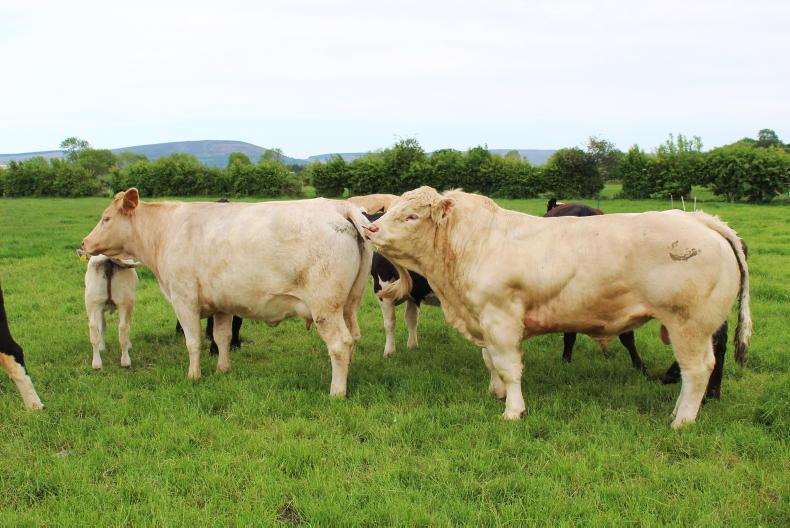
Suckler cows and stock bull.
This will more than likely be highlighted at pedigree sales but if you are purchasing a bull at home you need to be conscious of looking at the September 2023 index also.
1 Focus on quality as opposed to breed: the ICBF active bull list for AI beef sires clearly shows that the variation in the terminal and replacement index within breeds is much greater than the variation across breeds. The message is clear – the quality of the bull is more important than the breed.
Know your system and what you want the cattle to do within your system. If it’s the weanling market, a continental animal will be your choice, while if you are trying to finish cattle off grass at the end of the second grazing season, you need a traditional breed like Hereford, Shorthorn or Aberdeen Angus.

The herd stock bull Clonoulty Andraemon.
2 Buy the bull early: a lot of farmers make the mistake of purchasing the bull the day they want to put them to work. Take time to plan, keeping in mind the desired conception and calving dates for your herd, and just as importantly the production targets you want to obtain.
The bull should be purchased at least one month before his intended use, giving him time to adjust and settle in a new environment.
Make sure the bull has a ring and also make sure that he has a valid fertility test to avoid any fertility issues.
3 Don’t buy a bull on visual assessment alone: while visual assessment is still important, it should not be used as the only means of assessing the quality of the bull. You should also use the ICBF indexes when identifying which bull is best suited to your production system.
For example, if you are finishing all your animals then the terminal index is the most important index to concentrate on.
If you are a part-time farmer, then obviously you should also focus on a low calving difficulty percentage. If you are breeding replacements you need to focus on the replacement index more than the terminal index. Equally, don’t go on figures alone.
Over the last few years, I have seen more and more young people, in particular, landing to a bull sale with a list of bulls picked out of the catalogue and this is all they will look at in the sale.
Bulls could have three legs or two legs but they will still pick that bull because he is right on paper. This is not a good strategy to breed the cattle you want.
The best thing to do is look at the bull first and make sure you are happy with him, then look at his bloodlines to see if you like them and then make sure he has the figures to match before you select him as a potential purchase.

Look for any signs of paring on the feet which can be a sign of overfeeding.
4 Get the sale catalogue in time: a catalogue will usually be available seven to 10 days before the sale, and will provide essential information that you can use to make an informed decision and purchase exactly what you are looking for in your breeding programme.
Before opening the catalogue, rank the traits that are important to you. For example, is calving ease more important than milk or is daughter calving interval more important than beef carcase?
When you have the traits ranked, go to your catalogue and based on the figures/star ratings, identify a selection of bulls that are best suited to deliver what you require.
Remember, the recent changes in relation to the Suckler Carbon Efficiency Programme (SCEP) means that once a bull was genotyped four- or five-star on the September evaluation that means they are OK for siring eligible calves in SCEP.
The most recent evaluation will be printed in the catalogue but you also need to know the September 2023 figures if the bull has dropped since that. This will more than likely be highlighted.
5 Get to the sale early: the show will usually start between one and two hours before the start of sale. It is essential that you put this time to good use.
Get around and look at the bulls on your shortlist. If they are haltered, ask for them to be brought out on to a clean concrete area where you can get a close look at their feet.

Look for any signs of their feet having been pared. In the case of a young bull, if there is evidence of paring having already been carried out, stay well clear.
Pay close attention to how the bull walks. He should be moving freely and show no signs of stiffness or lameness.
By the time the sale is about to begin, you should have your shortlist reduced to two or three bulls. Never impulse-buy a bull that is not on your list just because you think he is cheap.
6 Talk to the breeder of the bull after the sale: if you have been successful in buying a bull, make sure to talk to the breeder after the sale. The key information you require is the feeding regime for the bull, eg what type of ration he was being fed, and the health status of the bull. Also, find out what vaccinations he received. For example, has he been vaccinated for blackleg, BVD, etc? Don’t forget to get a good luck penny!
7 Get the bull home and settled: get your new bull home and settled as soon as possible. Try to put him into a well-bedded pen where he can see other cattle and, where possible, try to get a few bags of the same ration that he was being fed before you purchased him. This will help reduce stress levels.

Remember, young bulls have had no breeding experience and therefore should not be treated in the same way as a mature stock bull. \ Ramona Farrelly
Concentrates should be reduced gradually to around 3kg to 4kg per day. Remember, young bulls have had no breeding experience and therefore should not be treated in the same way as a mature stock bull.
After the bull has settled, he should be let out into a paddock with a few cows that are either in-calf or not due to come in season.
After two to three weeks, introduce him to a few cows that are coming in season.
You should observe him closely to make sure he is doing the job correctly and inseminating the cow. Keep a close eye on these cows. If they repeat, alarm bells should start ringing and further investigation should be carried out immediately.
8 Don’t over-work a young bull: it is essential that you do not over-work a young stock bull in his first year. Twenty to 25 cows is the maximum he should be allowed to serve in year one. Ask the seller before purchase if the bull is fertility-tested.
Many society sales are now insisting that all bulls are fertility-tested. All too often, the young stock bull is forgotten about at the end of the breeding season.
By the end of the season, the bull will have lost condition.
It is important that he is fed well in order to get him built up again and in good condition before going into the winter. While you don’t want him fat, you want to make sure he is fit.

Look at the bull, then the figures, then the auctioneer.
9 Include the bull on your dosing and vaccination programme: it is important that you include the bull in the dosing programme. He should be dosed for worms throughout the grazing season and treated for fluke when housed. He should also be vaccinated for all vaccinations that cows are receiving including Lepto and BVD.
10 Purchase a genotyped bull: for farmers who are participating in SCEP, a four- or five-star bull on the terminal or replacement index must be purchased to sire eligible calves in SCEP. If the bull drops after genotyping, that is OK.
However, if the bull drops and he wasn’t genotyped, then the bull is ineligible.
Genotyped bulls will have a higher reliability and therefore there will be a less chance of his figures dropping in the future.
Remember, the recent changes in relation to SCEP means that once a bull was genotyped four- or five-star on the September evaluation that means they are OK for siring eligible calves in SCEP.
The most recent evaluation will be printed in the catalogue but you also need to know the September 2023 figures if the bull has dropped since that.

Suckler cows and stock bull.
This will more than likely be highlighted at pedigree sales but if you are purchasing a bull at home you need to be conscious of looking at the September 2023 index also.












 This is a subscriber-only article
This is a subscriber-only article










SHARING OPTIONS: